Effect of Fiber Content on the Mechanical Properties of Engineered Cementitious Composites with Recycled Fine Aggregate from Clay Brick
Abstract
1. Introduction
2. Experimental Program
2.1. Materials and Mix Proportions
2.2. Mechanical Properties Tests
3. Results and Discussion
3.1. The Effect of RFA Replacement
3.1.1. Compressive Strength and Flexural Strength
3.1.2. Bending Properties
3.1.3. Tensile Property
3.2. The Effects of PVA Fiber Content
3.2.1. Compressive Properties
3.2.2. Bending Properties
3.2.3. Tensile Properties
3.3. Microstructural Properties
3.4. Shrinkage and Creep
4. Conclusions
- (1)
- The fineness of RFA is similar to that of quartz sand, but the density is lower com-pared to quartz sand, and the surface of RFA is rough, resulting in lower RFA performance. Therefore, the compressive strength of ECO-ECC decreases with the increase of RFA replacement rate.
- (2)
- In the bending test, with the increase of RFA substitution rate, the cracking de-flection and ultimate deflection of ECO-ECC increased, and on the contrary, its cracking strength and ultimate strength decreased. It indicates that RFA has a certain effect on the ductility of ECC, but is not beneficial to the material matrix strength.
- (3)
- With the increase of fiber volume fraction, the compressive strength increases and then decreases, because the increase of fiber limits the transverse cracking of the matrix. Moreover, there is a good size effect between different sizes of compressive specimen.
- (4)
- With the increase of fiber volume fraction, the specimens all showed multi cracking and strain hardening. There is a good linear relationship between fiber volume fraction Vf and bending strength σu, and a linear equation is established.
- (5)
- From the SEM images, it can be seen that the fibers are uniformly distributed in the matrix, and in the damage diagram of the tensile specimen, it can be seen that the fiber damage is mainly tensile and shear damage, and the fiber bridging effect increases the strain of the specimen significantly.
Author Contributions
Funding
Institutional Review Board Statement
Informed Consent Statement
Data Availability Statement
Conflicts of Interest
Abbreviations
| RFA | recycled fine aggregate |
| RBM | recycled brick micro-powder |
| ECC | engineered cementitious composites |
| ECO-ECC | ecological engineered cementitious composites |
| OPC | ordinary Portland cement |
| FA | fly ash |
| PVA fiber | polyvinyl alcohol fiber |
| XRD | X-ray diffraction |
| T | thickener |
| SP | superplasticizer |
| Nc | number of cracks |
| Sc | crack space |
| Wc | crack width |
References
- Cheriyan, D.; Choi, J.H. A review of research on particulate matter pollution in the construction industry. J. Clean. Prod. 2020, 254, 120077. [Google Scholar] [CrossRef]
- Park, W.J.; Kim, R.; Roh, S.; Ban, H. Analysis of major environmental impact categories of road construction materials. Sustainability 2020, 12, 6951. [Google Scholar] [CrossRef]
- Kuzielová, E.; Slaný, M.; Žemlička, M.; Másilko, J.; Palou, M.T. Phase Composition of Silica Fume—Portland Cement Systems Formed under Hydrothermal Curing Evaluated by FTIR, XRD, and TGA. Materials 2021, 14, 2786. [Google Scholar] [CrossRef] [PubMed]
- Wen, B.; Musa, S.N.; Onn, C.C.; Ramesh, S.; Liang, L.; Wang, W.; Ma, K. The role and contribution of green buildings on sustainable development goals. Build. Environ. 2020, 185, 107091. [Google Scholar] [CrossRef]
- Maraveas, C. Production of sustainable construction materials using agro-wastes. Materials 2020, 13, 262. [Google Scholar] [CrossRef]
- Peng, Z.; Shi, C.; Shi, Z.; Lu, B.; Wan, S.; Zhang, Z.; Chang, J.; Zhang, T. Alkali-aggregate reaction in recycled aggregate concrete. J. Clean. Prod. 2020, 255, 120238. [Google Scholar] [CrossRef]
- Li, V.C.; Wang, S. Tensile strain-hardening behavior of PVA-ECC. ACI Mater. J. 2001, 98, 483–492. [Google Scholar]
- Zhou, S.; Xie, L.; Jia, Y.; Wang, C. Review of Cementitious Composites Containing Polyethylene Fibers as Repairing Materials. Polymers 2020, 12, 2624. [Google Scholar] [CrossRef]
- Sahmaran, M.; Lachemi, M.; Hossain, K.M.A.; Ranade, R.; Li, V.C. Influence of aggregate type and size on ductility and mechanical properties of engineered cementitious composites. ACI Mater. J. 2009, 106, 308–316. [Google Scholar]
- Fischer, G.; Li, V.C. Influence of matrix ductility on tension-stiffening behavior of steel reinforced engineered cementitious composites (ECC). ACI Struct. J. 2002, 99, 104–111. [Google Scholar]
- Kanda, T.; Li, V.C. Interface property and apparent strength of high-strength hydrophilic fiber in cement matrix. J. Mater. Civ. Eng. 1998, 10, 43598. [Google Scholar] [CrossRef]
- Li, V.C.; Wu, H.C. Conditions for pseudo strain-hardening in fiber reinforced brittle matrix composites. Appl. Mech. Rev. 1992, 45, 390–398. [Google Scholar] [CrossRef]
- Wang, S.X.; Li, V.C. Polyvinyl alcohol fiber reinforced engineered cementitious composites: Material design and performances. In Proceedings of the International RILEM Workshop on HPFRCC in Structural Applications, Honolulu, HI, USA, 23–26 May 2006; pp. 65–73. [Google Scholar]
- Yu, K.; Ding, Y.; Zhang, Y.X. Size effects on tensile properties and compressive strength of engineered cementitious composites. Cem. Concr. Compos. 2020, 113, 103691. [Google Scholar] [CrossRef]
- Liu, H.Z.; Zhang, Q.; Gu, C.S.; Su, H.Z.; Li, V.C. Influence of micro-cracking on the permeability of engineered cementitious composites. Cem. Concr. Compos. 2016, 72, 104–113. [Google Scholar] [CrossRef]
- Marcalikova, Z.; Cajka, R.; Bilek, V.; Bujdos, D.; Sucharda, O. Determination of Mechanical Characteristics for Fiber-Reinforced Concrete with Straight and Hooked Fibers. Crystals 2020, 10, 545. [Google Scholar] [CrossRef]
- Arce, G.A.; Noorvand, H.; Hassan, M.M.; Rupnow, T.; Dhakal, N. Feasibility of low fiber content PVA-ECC for jointless pavement application. Constr. Build. Mater. 2020, 268, 121131. [Google Scholar] [CrossRef]
- Kumar, N.P.; Shirisha, C. An area-efficient ECC architecture over GF (2m) for resource-constrained applications. AEU-Int. J. Electron. Commun. 2020, 125, 153383. [Google Scholar] [CrossRef]
- Yu, K.Q.; Zhu, W.J.; Ding, Y.; Lu, Z.D.; Yu, J.T.; Xiao, J.Z. Micro-structural and mechanical properties of ultra-high performance engineered cementitious composites (UHP-ECC) incorporation of recycled fine powder (RFP). Cem. Concr. Res. 2019, 124, 105813. [Google Scholar] [CrossRef]
- Zhao, J.J.; Yan, C.W.; Liu, S.G.; Zhang, J.; Li, S.; Yan, Y. Effect of solid waste ceramic on uniaxial tensile properties and thin plate bending properties of polyvinyl alcohol engineered cementitious composite. J. Clean. Prod. 2020, 268, 122329. [Google Scholar] [CrossRef]
- Gao, D.Y.; Lv, M.; Yang, L.; Tang, J.; Chen, G.; Meng, Y. Experimental study of utilizing recycled fine aggregate for the preparation of high ductility cementitious composites. Materials 2020, 13, 679. [Google Scholar] [CrossRef]
- Wang, J.G.; Zhang, J.X.; Cao, D.D.; Dang, H.X.; Ding, B. Comparison of recycled aggregate treatment methods on the performance for recycled concrete. Constr. Build. Mater. 2020, 234, 117366. [Google Scholar] [CrossRef]
- Thomas, C.; de Brito, J.; Cimentada, A.; Sainz-Aja, J.A. Macro- and micro- properties of multi-recycled aggregate concrete. J. Clean. Prod. 2020, 245, 118843. [Google Scholar] [CrossRef]
- Jalilifar, H.; Sajedi, F. Micro-structural analysis of recycled concretes made with recycled coarse concrete aggregates. Constr. Build. Mater. 2020, 267, 121041. [Google Scholar] [CrossRef]
- Martínez-García, R.; Jagadesh, P.; Fraile-Fernández, F.J.; Morándel Pozo, J.M.; Juan-Valdés, A. Influence of Design Parameters on Fresh Properties of Self-Compacting Concrete with Recycled Aggregate—A Review. Materials 2020, 13, 5749. [Google Scholar] [CrossRef]
- Moetaz, E.H.; Abdullah, A.S. Internal curing of recycled aggregates concrete. J. Clean. Prod. 2020, 275, 122911. [Google Scholar]
- Slaný, M.; Jankovič, Ľ.; Madejová, J. Structural characterization of organo-montmorillonites prepared from a series of primary alkylamines salts: Mid-IR and near-IR study. Appl. Clay Sci. 2019, 176, 11–20. [Google Scholar] [CrossRef]
- JSCE. Recommendations for Design and Construction of High Performance Fiber Reinforced Cement Composites with Multiple Fine Cracks; Japan Society of Civil Engineers: Tokyo, Japan, 2008; pp. 1–16. [Google Scholar]
- Chinese Standard GB/T 15231-2008. Test Methods for the Properties of Glass Fibre Reinforced Cement; Chinese Standard: Beijing, China, 2009. [Google Scholar]
- Du, Q.; Cai, C.; Lv, J.; Wu, J.; Pan, T.; Zhou, J. Experimental investigation on the mechanical properties and microstructures of basalt fiber reinforced engineered cementitious composite. Materials 2020, 13, 3796. [Google Scholar] [CrossRef]
- Chen, F.; Wu, K.; Ren, L.J.; Xu, J.N.; Zheng, H.M. Internal Curing Effect and Compressive Strength Calculation of Recycled Clay Brick Aggregate Concrete. Materials 2019, 12, 1815. [Google Scholar] [CrossRef] [PubMed]
- Li, J.X.; Yang, E.H. Macroscopic and microstructural properties of engineered cementitious composites incorporating recycled concrete fines. Cem. Concr. Compos. 2017, 78, 33–42. [Google Scholar] [CrossRef]
- Yu, J.T.; Jiang, F.M.; Yu, K.Q.; Dong, F.Y.; Duan, X.Z. Deformability enhancement of fiber-reinforced cementitious composite by incorporating recycled powder. J. Reinf. Plasti. Compos. 2019, 39, 119–131. [Google Scholar] [CrossRef]
- Wang, Y.; Liu, F.; Yu, J.; Dong, F.; Ye, J. Effect of polyethylene fiber content on physical and mechanical properties of engineered cementitious composites. Constr. Build. Mater. 2020, 251, 118917. [Google Scholar] [CrossRef]
- Nepomuceno, M.; Isidoro, R.; Catarino, J. Mechanical performance evaluation of concrete made with recycled ceramic coarse aggregates from industrial brick waste. Constr. Build. Mater. 2018, 165, 284–294. [Google Scholar] [CrossRef]
- Joohari, I.; Ishak, N.F.; Amin, N.M. Mechanical Properties of Lightweight Concrete Using Recycled Cement-Sand Brick as Coarse Aggregates Replacement. E3S Web Conf. 2018, 34, 01029. [Google Scholar] [CrossRef]
- Pan, Z.; Wu, C.; Liu, J.; Wang, W.; Liu, J. Study on mechanical properties of cost-effective polyvinyl alcohol engineered cementitious composites (PVA-ECC). Constr. Build. Mater. 2015, 789, 397–404. [Google Scholar] [CrossRef]
- Wendling, A.; Sadhasivam, K.; Floyd, R.W. Creep and shrinkage of lightweight self-consolidating concrete for prestressed members. Constr. Build. Mater. 2018, 167, 205–215. [Google Scholar] [CrossRef]
- Silva, R.V.; De Brito, J.; Dhir, R.K. Prediction of the shrinkage behavior of recycled aggregate concrete: A review. Constr. Build. Mater. 2015, 77, 327–339. [Google Scholar] [CrossRef]
- Bravo, M.; De Brito, J.; Pontes, J.; Evangelista, L. Shrinkage and creep performance of concrete with recycled aggregates from CDW plants. Mag. Concr. Res. 2017, 69, 974–995. [Google Scholar] [CrossRef]
- Ishtiaq, A.S.; Roy, S. Creep behavior and its prediction for normal strength concrete made from crushed clay bricks as coarse aggregate. J. Mater. Civ. Eng. 2012, 24, 308–314. [Google Scholar] [CrossRef]
- Lye, C.Q.; Dhir, R.K.; Ghataora, G.S.; Li, H. Creep strain of recycled aggregate concrete. Constr. Build. Mater. 2016, 102, 244–259. [Google Scholar] [CrossRef]

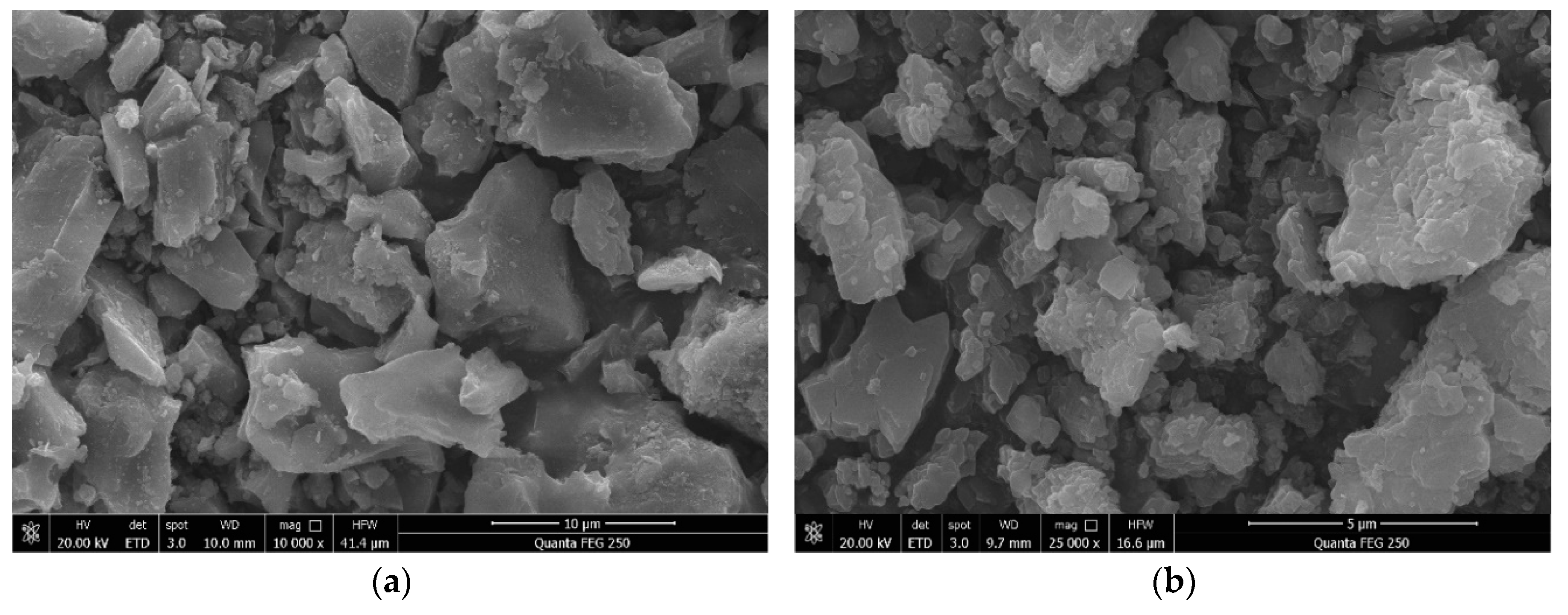
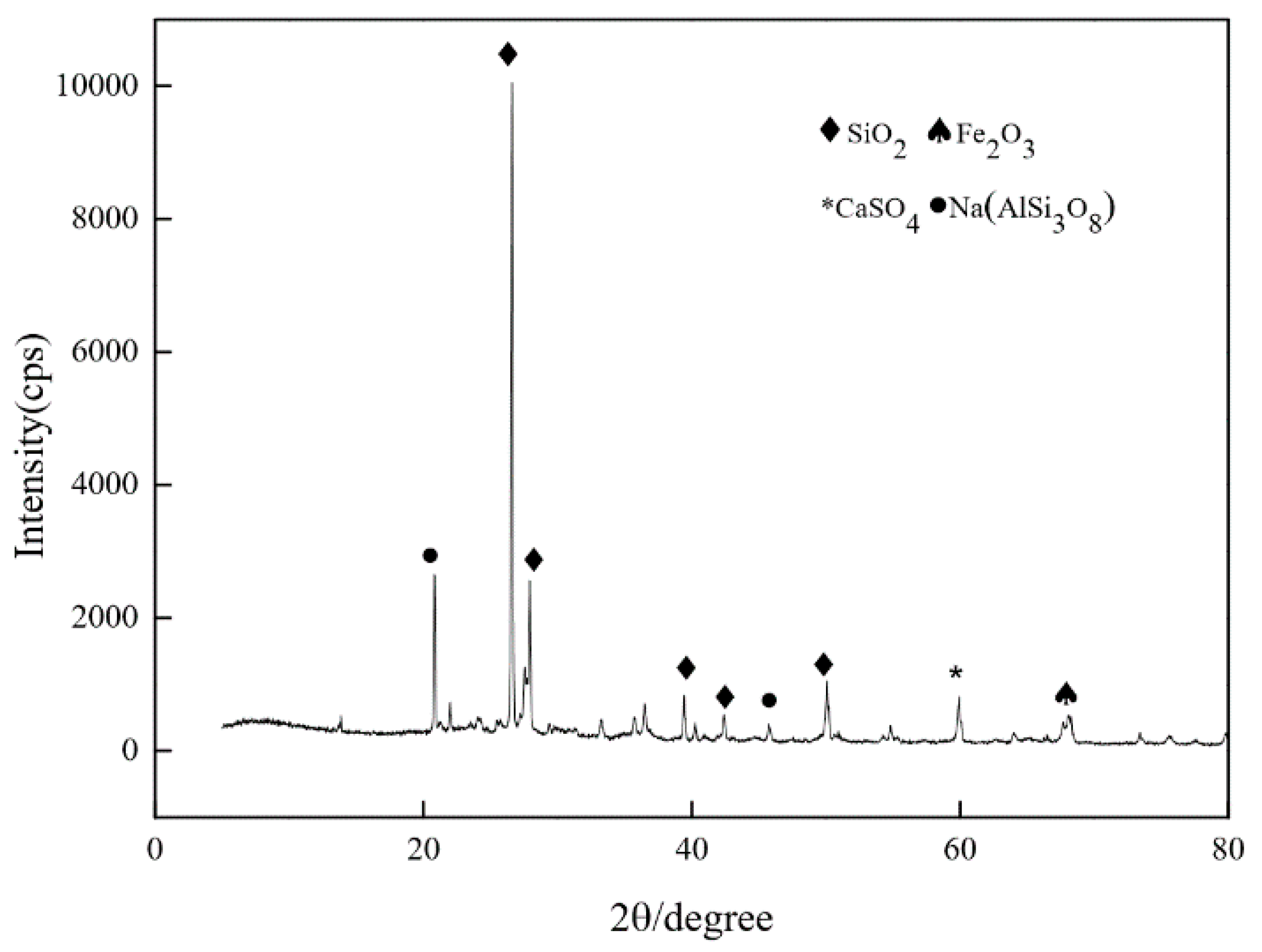
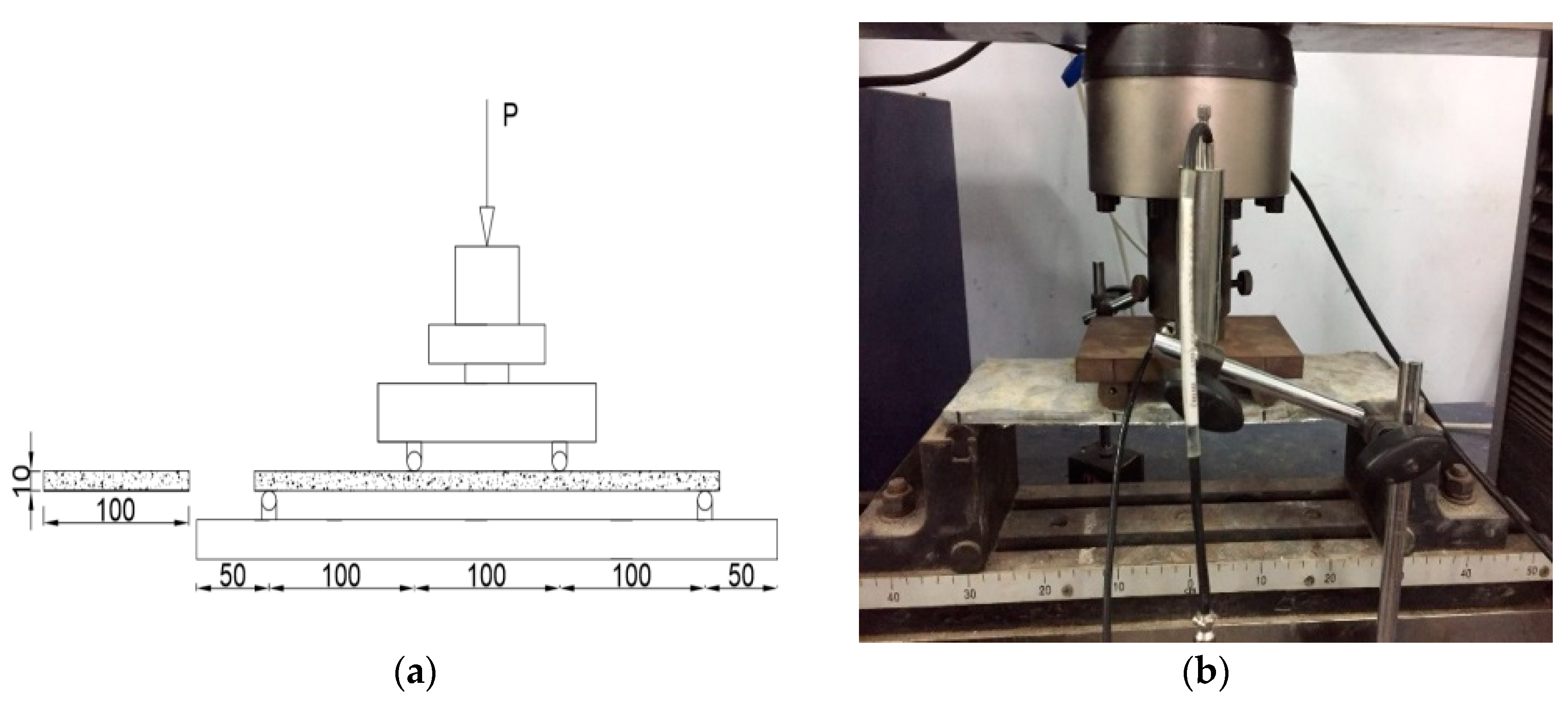

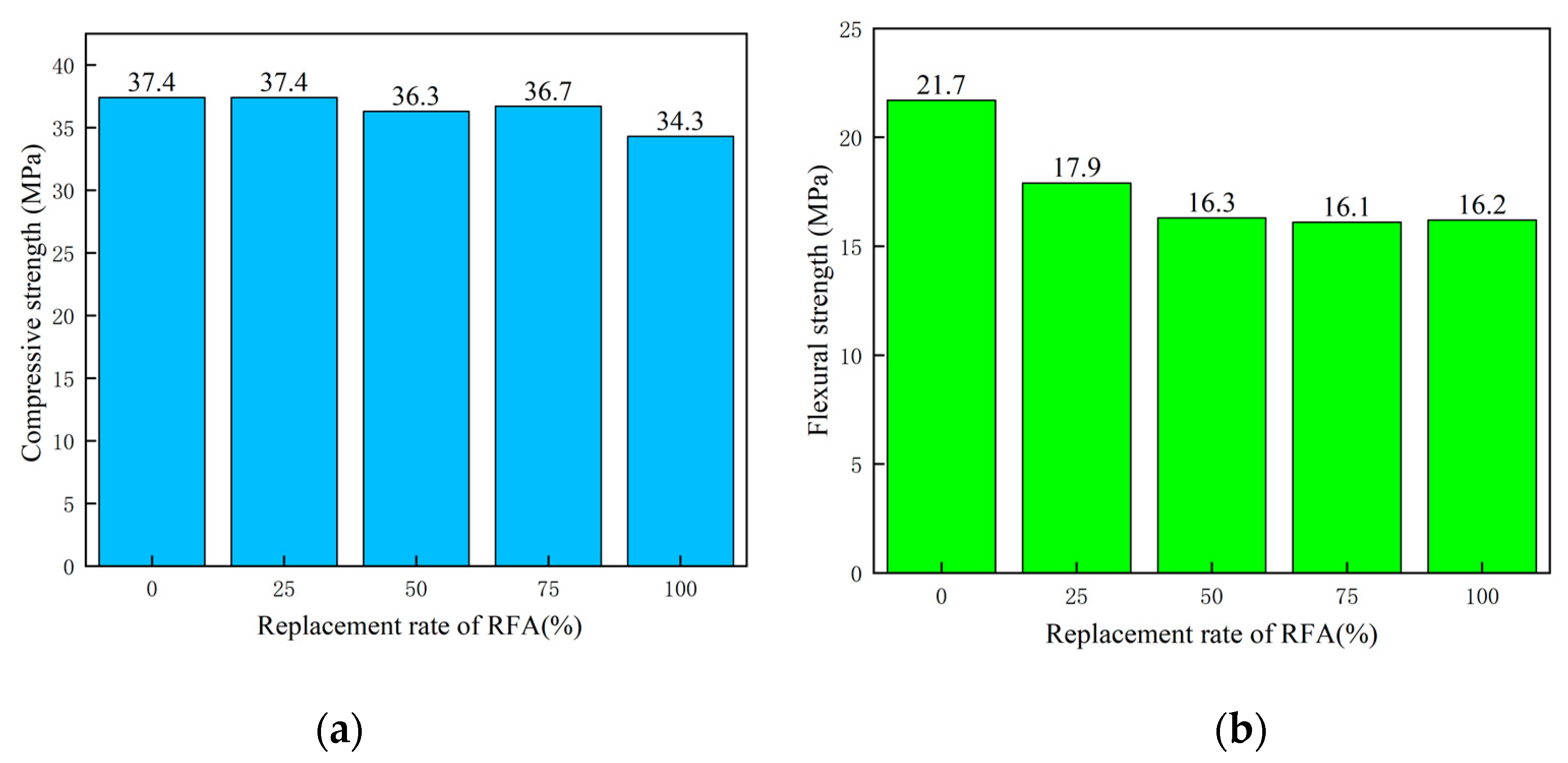
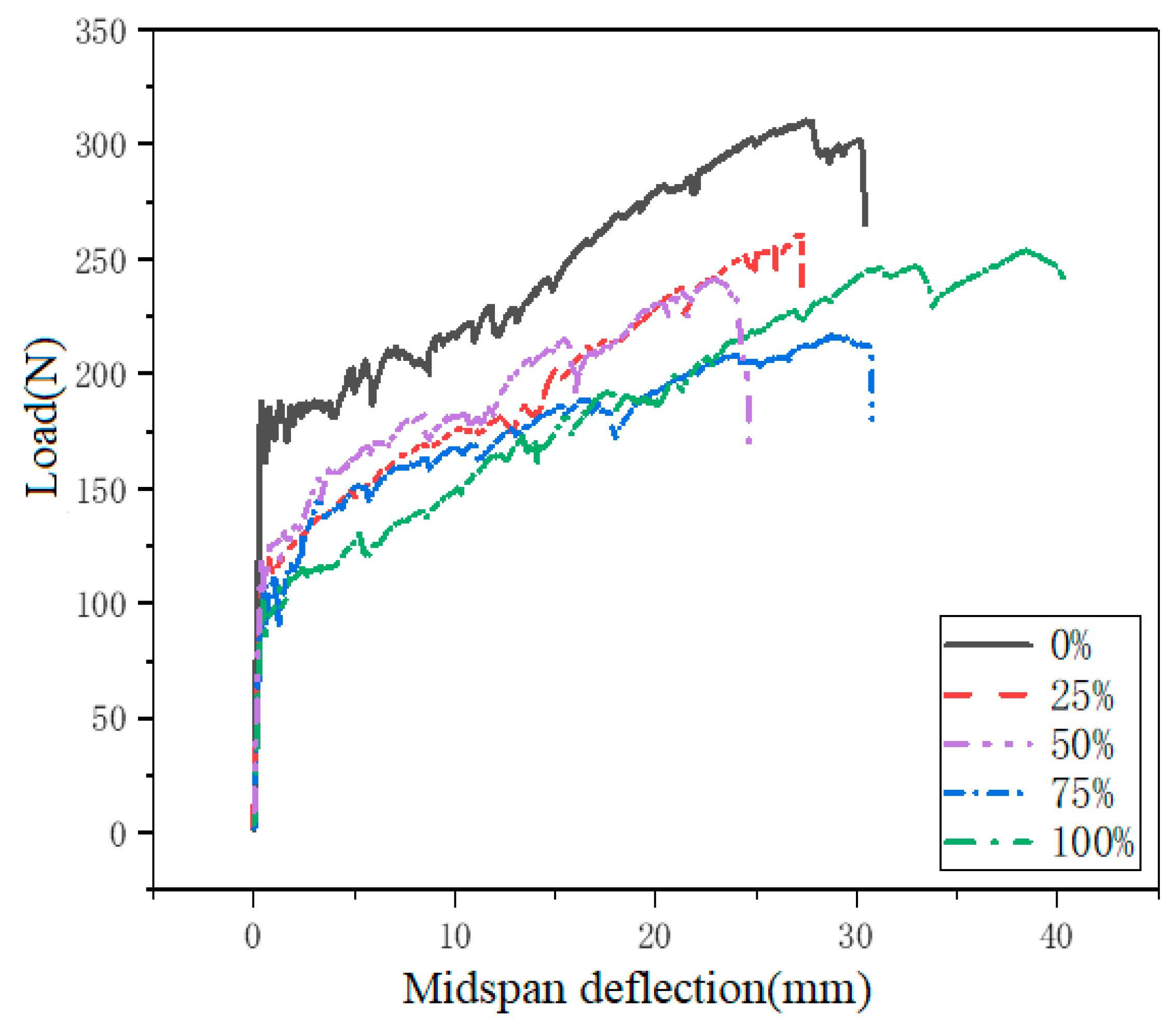



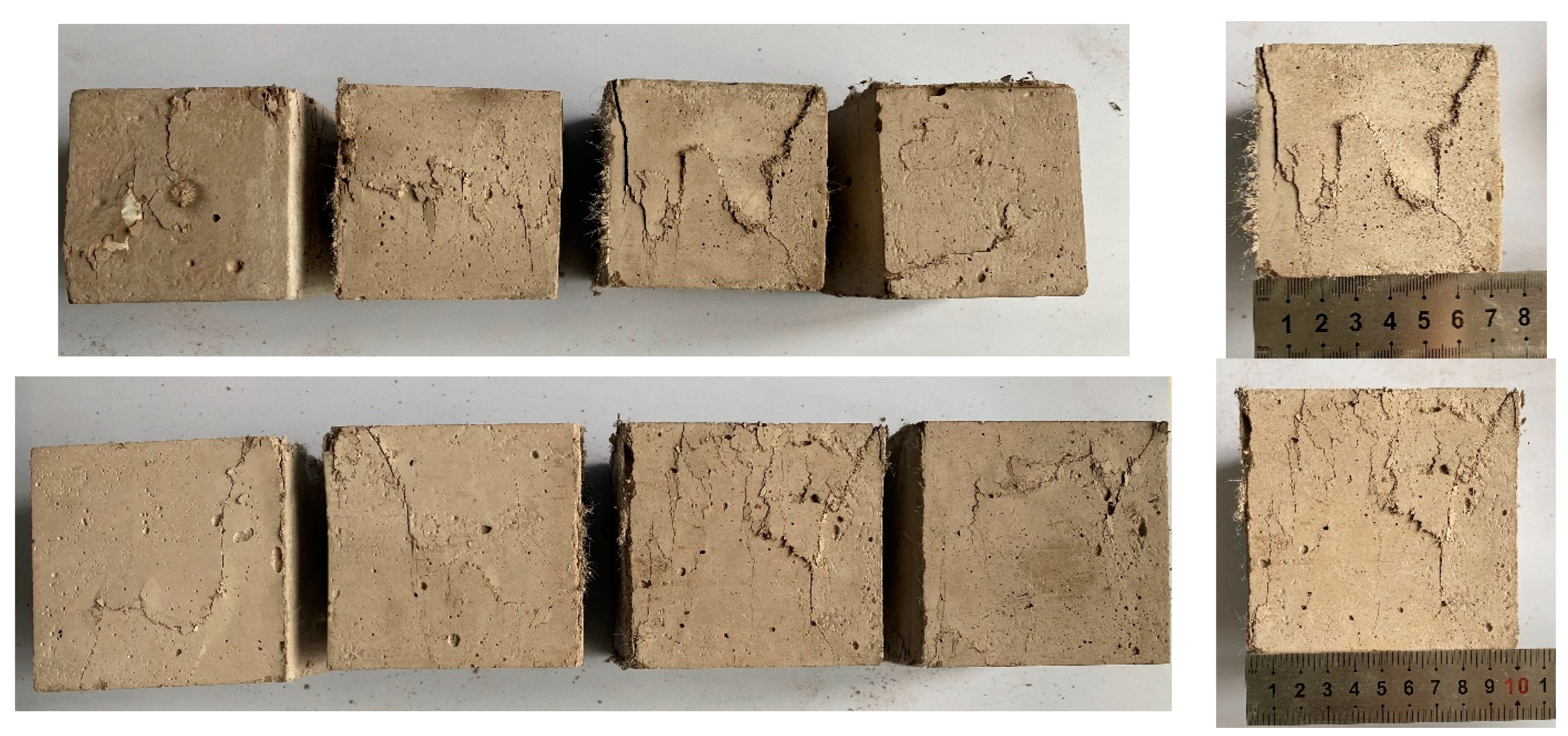
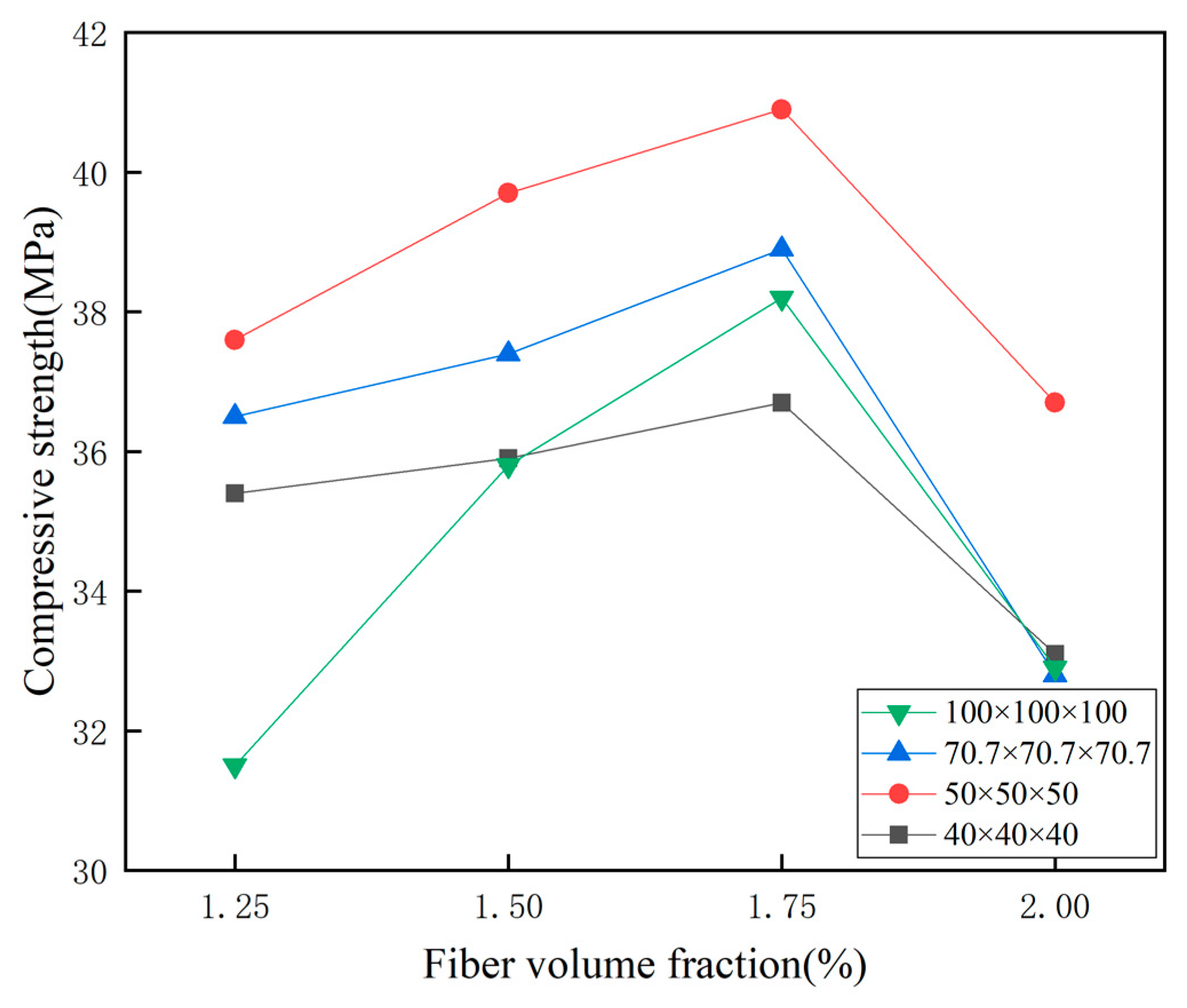
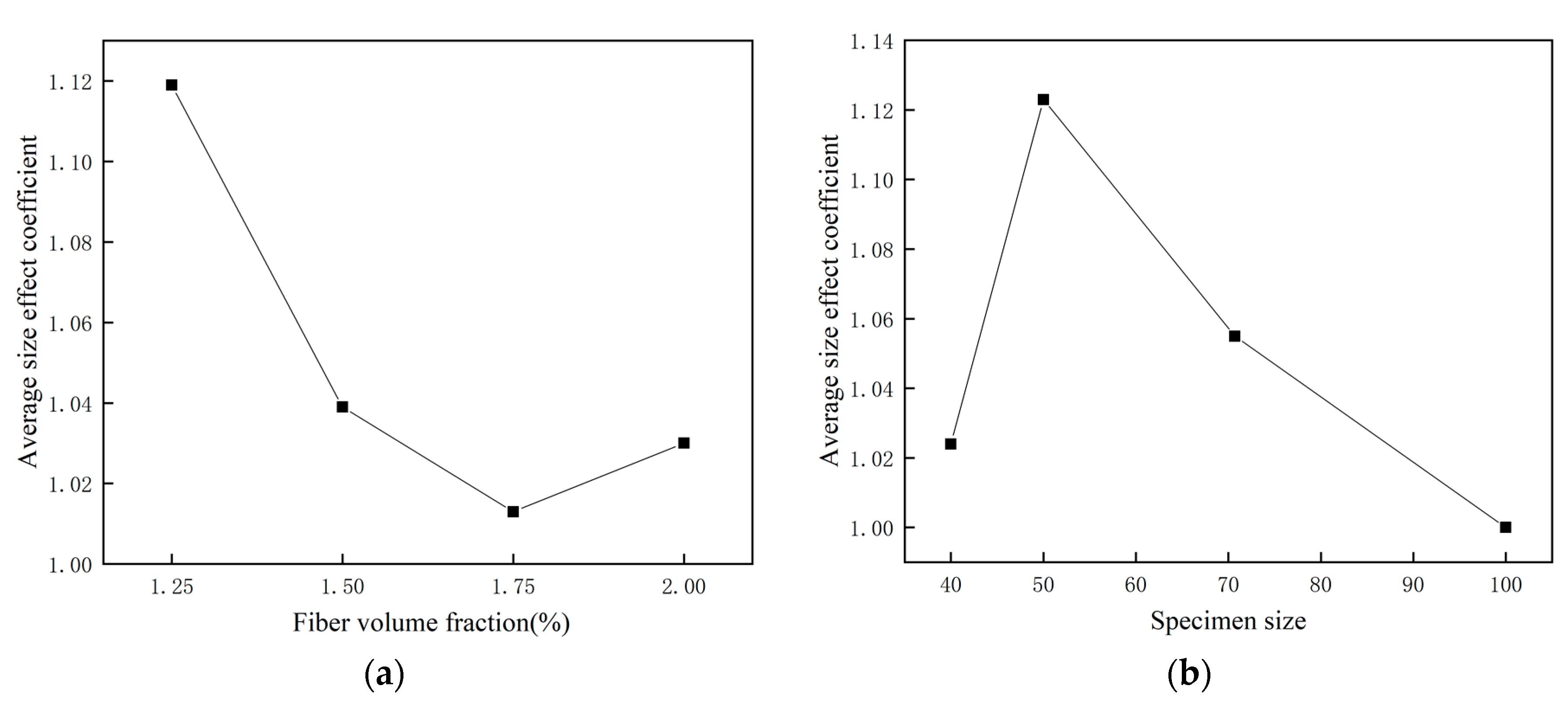

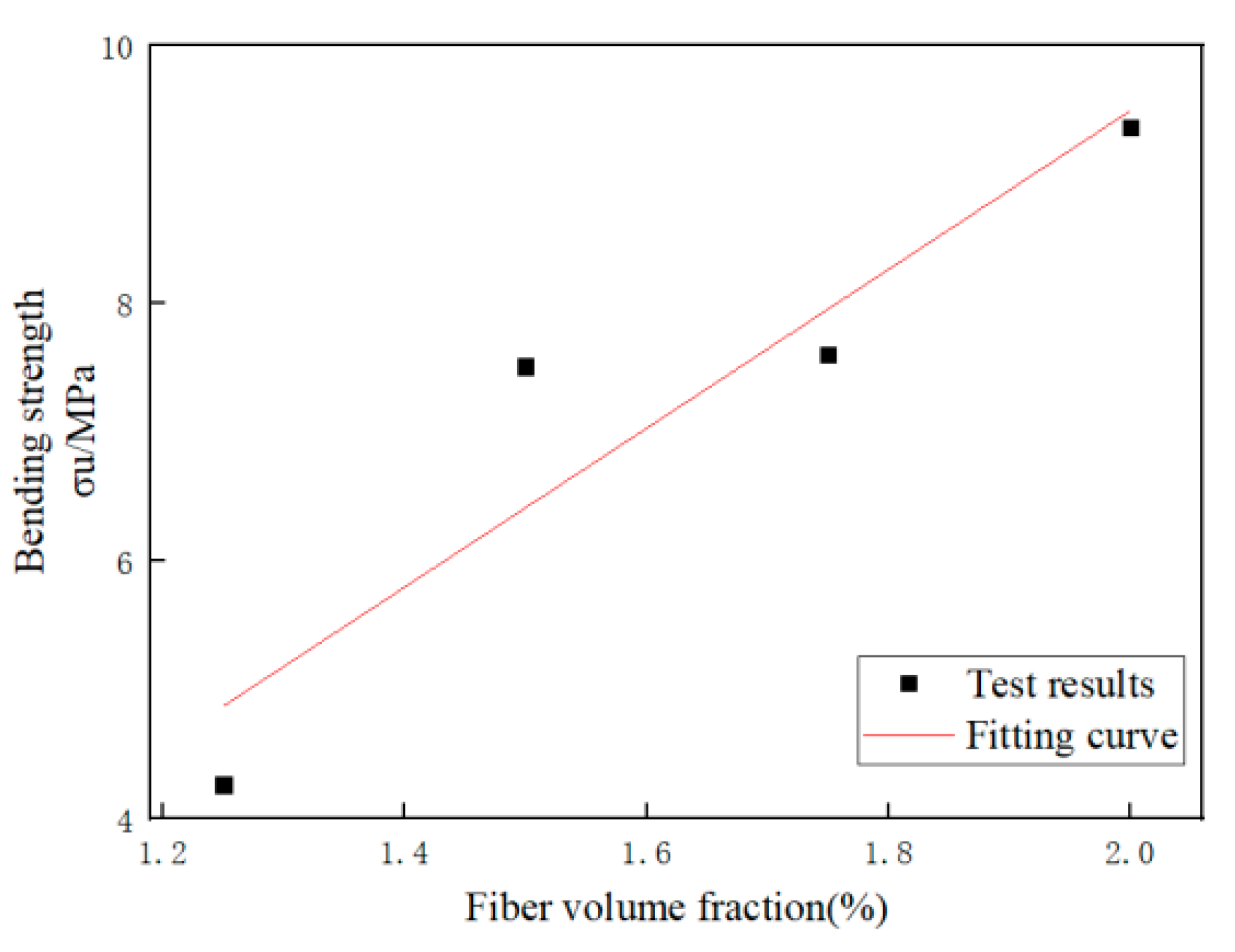

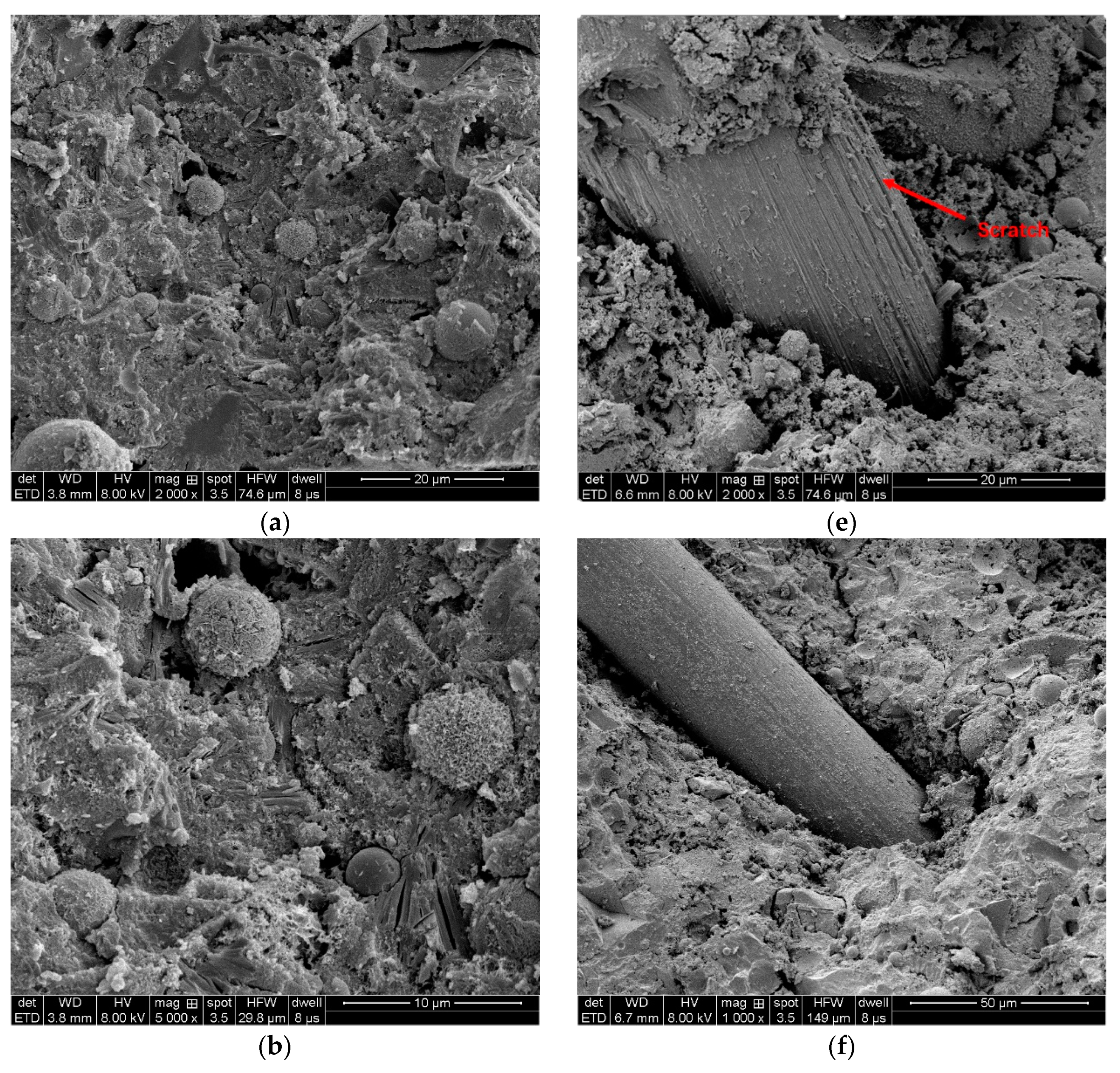

| Chemical | OPC | FA | OPC | |
|---|---|---|---|---|
| Composition (%) | Properties | |||
| Fe2O3 | 3.90 | 4.16 | Specific gravity (g/cm3) | 3.08 ± 0.02 |
| CaO | 60.88 | 4.01 | Cement Blaine (m2/kg) | 370 ± 7.9 |
| MgO | 1.75 | 1.01 | Initial setting time (min) | 150 ± 9 |
| SiO2 | 21.46 | 53.97 | Final setting time (min) | 205 ± 16 |
| Al2O3 | 7.28 | 31.15 | Compressive strength (MPa) | - |
| SO3 | 2.58 | - | 3 days | 25.2 ± 1.9 |
| Na2O | - | 0.89 | 28 days | 48.5 ± 2.1 |
| Particle Size (μm) | <75 | 75–125 | 125–150 | 150–200 | 200–300 |
|---|---|---|---|---|---|
| content (%) | 4.25 | 20.67 | 34.92 | 39.72 | 0.44 |
| Diameter (µm) | Length (mm) | Tensile Strength (MPa) | Elastic Modulus (GPa) | Elongation at Break (%) | Density (g·cm−3) |
|---|---|---|---|---|---|
| 40 | 12 | 1560 | 41 | 6.5 | 1.3 |
| Aggregate Type | Apparent Density/kg·m−3 | Bulk Density/kg·m−3 | Water Absorption/% | Porosity/% |
|---|---|---|---|---|
| RFA | 2362 | 993.8 | 31.8 | 15.1 |
| Test Group | Water | Cement | FA | Quartz Sand | RFA | SP | T | PVA Fiber |
|---|---|---|---|---|---|---|---|---|
| ECC-QS | 415 | 770 | 415 | 415 | 0 | 0.6 | 1.8 | 22.75 |
| ECC-RFA25 | 415 | 770 | 415 | 311.25 | 103.75 | 0.6 | 1.8 | 22.75 |
| ECC-RFA50 | 415 | 770 | 415 | 207.5 | 207.5 | 0.6 | 1.8 | 22.75 |
| ECC-RFA75 | 415 | 770 | 415 | 103.75 | 311.25 | 0.6 | 1.8 | 22.75 |
| ECC-RFA100 | 415 | 770 | 415 | 0 | 415 | 0.6 | 1.8 | 22.75 |
| Test Group | Water | Cement | FA | RFA | PVA Fiber | SP | T |
|---|---|---|---|---|---|---|---|
| ECO-ECC-1.25% | 415 | 770 | 415 | 415 | 16.25 | 0.6 | 1.8 |
| ECO-ECC-1.50% | 415 | 770 | 415 | 415 | 19.5 | 0.6 | 1.8 |
| ECO-ECC-1.75% | 415 | 770 | 415 | 415 | 22.75 | 0.6 | 1.8 |
| ECO-ECC-2% | 415 | 770 | 415 | 415 | 26 | 0.6 | 1.8 |
| Test Group | Compressive Strength (MPa) | Standard Deviation (MPa) | Flexural Strength (MPa) | Standard Deviation (MPa) |
|---|---|---|---|---|
| ECC-QS | 37.4 | 1.03 | 21.7 | 0.39 |
| ECC-RFA25 | 36.3 | 0.98 | 17.9 | 0.47 |
| ECC-RFA50 | 36.7 | 0.78 | 16.3 | 0.31 |
| ECC-RFA75 | 34.3 | 0.56 | 16.1 | 0.29 |
| ECC-RFA100 | 33.7 | 0.63 | 16.2 | 0.24 |
| Test Group | First Cracking Deflection δc/mm | Ultimate Deflection δc/mm | First Cracking Strength σc/MPa | Standard Deviation σc/(MPa) | Bending Peak Strength σu/MPa | Standard Deviation σu/(MPa) |
|---|---|---|---|---|---|---|
| ECC-QS | 0.366 | 27.89 | 5.598 | 0.34 | 9.129 | 0.46 |
| ECC-RFA25 | 0.695 | 27.119 | 3.393 | 0.24 | 7.841 | 0.39 |
| ECC-RFA50 | 0.368 | 23.345 | 3.606 | 0.29 | 7.269 | 0.34 |
| ECC-RFA75 | 0.532 | 29.164 | 3.234 | 0.27 | 6.513 | 0.22 |
| ECC-RFA100 | 0.976 | 38.49 | 3.018 | 0.20 | 7.602 | 0.29 |
| Test Group | Cracking Strain εct (%) | Cracking Stress σct (MPa) | Standard Deviation σct/(MPa) | Ultimate Strain εut (%) | Ultimate Stress σut (MPa) | Standard Deviation σut/(MPa) |
|---|---|---|---|---|---|---|
| ECC-QS | 0.067 | 2.271 | 0.22 | 2.131 | 3.548 | 0.31 |
| ECC-RFA25 | 0.099 | 2.188 | 0.16 | 2.352 | 2.936 | 0.34 |
| ECC-RFA50 | 0.066 | 1.887 | 0.18 | 1.381 | 1.935 | 0.29 |
| ECC-RFA75 | 0.158 | 1.833 | 0.13 | 2.374 | 2.252 | 0.25 |
| ECC-RFA100 | 0.235 | 1.792 | 0.20 | 3.301 | 2.168 | 0.21 |
| Test Group | Nc | Wc (μm) | Sc (mm) |
|---|---|---|---|
| ECC-QS | 24 ± 3 | 179 ± 5 | 5.00 ± 0.71 |
| ECC-RFA25 | 30 ± 3 | 151 ± 6 | 4.00 ± 0.44 |
| ECC-RFA50 | 21 ± 3 | 183 ± 7 | 5.71 ± 0.96 |
| ECC-RFA75 | 35 ± 5 | 133 ± 6 | 3.43 ± 0.57 |
| ECC-RFA100 | 41 ± 4 | 118 ± 7 | 2.93 ± 0.31 |
| Test Group | Fcu, 40 | Standard Deviation | Fcu, 50 | Standard Deviation | Fcu, 70.7 | Standard Deviation | Fcu, 100 | Standard Deviation |
|---|---|---|---|---|---|---|---|---|
| ECO-ECC-1.25% | 35.4 | 0.679 | 37.6 | 0.598 | 36.5 | 0.652 | 31.5 | 0.438 |
| ECO-ECC-1.50% | 35.9 | 0.579 | 39.7 | 0.989 | 37.4 | 0.785 | 35.8 | 0.964 |
| ECO-ECC-1.75% | 36.7 | 0.435 | 40.9 | 0.756 | 38.9 | 0.719 | 38.2 | 0.856 |
| ECO-ECC-2% | 33.1 | 0.958 | 36.7 | 0.245 | 32.8 | 0.871 | 32.9 | 1.005 |
| Test Group | Fcu, 40 | Size Effect Coefficient | Fcu, 50 | Size Effect Coefficient | Fcu, 70.7 | Size Effect Coefficient | Fcu, 100 | Size Effect Coefficient | Average |
|---|---|---|---|---|---|---|---|---|---|
| ECO-ECC-1.25% | 35.4 | 1.124 | 37.6 | 1.194 | 36.5 | 1.159 | 31.5 | 1 | 1.119 |
| ECO-ECC-1.50% | 35.9 | 1.003 | 39.7 | 1.109 | 37.4 | 1.045 | 35.8 | 1 | 1.039 |
| ECO-ECC-1.75% | 36.7 | 0.961 | 40.9 | 1.071 | 38.9 | 1.018 | 38.2 | 1 | 1.013 |
| ECO-ECC-2% | 33.1 | 1.006 | 36.7 | 1.116 | 32.8 | 0.997 | 32.9 | 1 | 1.030 |
| average | - | 1.024 | - | 1.123 | - | 1.055 | - | 1 | - |
| Test Group | The First Cracking Deflection δc (mm) | Ultimate Deflection δu (mm) | The First Cracking Strength σc (MPa) | Standard Deviation σc/(MPa) | Bending Peak Strength σu (MPa) | Standard Deviation σu/(MPa) |
|---|---|---|---|---|---|---|
| ECO-ECC-1.25% | 0.30 | 20.20 | 3.36 | 0.22 | 4.26 | 0.19 |
| ECO-ECC-1.5% | 0.96 | 32.93 | 3.10 | 0.19 | 7.51 | 0.23 |
| ECO-ECC-1.75% | 0.98 | 38.49 | 3.02 | 0.16 | 7.60 | 0.18 |
| ECO-ECC-2% | 1.82 | 44.87 | 2.73 | 0.20 | 9.36 | 0.15 |
| Category | Functional Relation | Correlation Coefficient R2 |
|---|---|---|
| σu—Vf | σu = 6.16 Vf − 2.823 | 0.874 |
| Test Group | Cracking Strain εct | Cracking Stress σct (MPa) | Standard Deviation σc/(MPa) | Ultimate Strain εut | Ultimate Stress σut (MPa) | Standard Deviation σc/(MPa) |
|---|---|---|---|---|---|---|
| ECO-ECC-1.25% | 0.189 | 1.112 | 0.13 | 1.31 | 1.752 | 0.16 |
| ECO-ECC-1.5% | 0.207 | 1.792 | 0.16 | 2.04 | 2.036 | 0.14 |
| ECO-ECC-1.75% | 0.235 | 1.892 | 0.15 | 3.00 | 3.368 | 0.23 |
| ECO-ECC-2% | 0.264 | 2.336 | 0.18 | 4.19 | 3.456 | 0.21 |
Publisher’s Note: MDPI stays neutral with regard to jurisdictional claims in published maps and institutional affiliations. |
© 2021 by the authors. Licensee MDPI, Basel, Switzerland. This article is an open access article distributed under the terms and conditions of the Creative Commons Attribution (CC BY) license (https://creativecommons.org/licenses/by/4.0/).
Share and Cite
Cheng, Z.; Yan, W.; Sui, Z.; Tang, J.; Yuan, C.; Chu, L.; Feng, H. Effect of Fiber Content on the Mechanical Properties of Engineered Cementitious Composites with Recycled Fine Aggregate from Clay Brick. Materials 2021, 14, 3272. https://doi.org/10.3390/ma14123272
Cheng Z, Yan W, Sui Z, Tang J, Yuan C, Chu L, Feng H. Effect of Fiber Content on the Mechanical Properties of Engineered Cementitious Composites with Recycled Fine Aggregate from Clay Brick. Materials. 2021; 14(12):3272. https://doi.org/10.3390/ma14123272
Chicago/Turabian StyleCheng, Zhanqi, Wenhao Yan, Zhibo Sui, Jiyu Tang, Chengfang Yuan, Liusheng Chu, and Hu Feng. 2021. "Effect of Fiber Content on the Mechanical Properties of Engineered Cementitious Composites with Recycled Fine Aggregate from Clay Brick" Materials 14, no. 12: 3272. https://doi.org/10.3390/ma14123272
APA StyleCheng, Z., Yan, W., Sui, Z., Tang, J., Yuan, C., Chu, L., & Feng, H. (2021). Effect of Fiber Content on the Mechanical Properties of Engineered Cementitious Composites with Recycled Fine Aggregate from Clay Brick. Materials, 14(12), 3272. https://doi.org/10.3390/ma14123272







